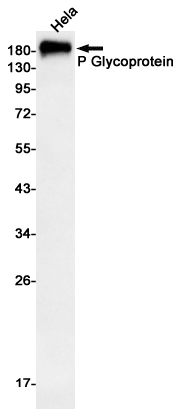
| WB | 1/500-1/1000 | Human,Mouse,Rat |
| IF | 咨询技术 | Human,Mouse,Rat |
| IHC | 咨询技术 | Human,Mouse,Rat |
| ICC | 技术咨询 | Human,Mouse,Rat |
| FCM | 咨询技术 | Human,Mouse,Rat |
| Elisa | 咨询技术 | Human,Mouse,Rat |
| Aliases | p-pg; ABCB1; MDR1; PGY1; Multidrug resistance protein 1; ATP-binding cassette sub-family B member 1; P-glycoprotein 1; CD antigen CD243 |
| Entrez GeneID | 5243 |
| WB Predicted band size | Calculated MW: 141 kDa; Observed MW: 130-180 kDa |
| Host/Isotype | Rabbit IgG |
| Antibody Type | Primary antibody |
| Storage | Store at 4°C short term. Aliquot and store at -20°C long term. Avoid freeze/thaw cycles. |
| Species Reactivity | Human |
| Immunogen | Recombinant protein of human P Glycoprotein |
| Formulation | Purified antibody in TBS with 0.05% sodium azide,0.05%BSA and 50% glycerol. |
+ +
以下是3-4条关于P糖蛋白(P-glycoprotein,P-gp)抗体的经典文献及其摘要概括:
---
1. **文献名称**:*A surface glycoprotein modulating drug permeability in Chinese hamster ovary cell mutants*
**作者**:Juliano, R.L., Ling, V.
**摘要**:首次鉴定了P糖蛋白(P-gp)作为细胞膜上的药物外排泵,揭示了其在多药耐药性中的作用,为后续抗体的开发奠定基础(发表于*Biochimica et Biophysica Acta*, 1976)。
---
2. **文献名称**:*Biochemistry of multidrug resistance mediated by the multidrug transporter*
**作者**:Gottesman, M.M., Pastan, I.
**摘要**:系统总结了P-gp的结构、功能及其介导的药物外排机制,强调抗体在研究其表达和功能中的应用(发表于*Annual Review of Biochemistry*, 1993)。
---
3. **文献名称**:*Expression of the multidrug resistance gene product (P-glycoprotein) in human normal and tumor tissues*
**作者**:Cordon-Cardo, C., et al.
**摘要**:利用单克隆抗体(如C219)检测P-gp在正常组织和肿瘤组织的表达,证实其在多种癌症中的耐药相关性(发表于*Journal of Histochemistry & Cytochemistry*, 1989)。
---
4. **文献名称**:*Revisiting the role of ABC transporters in multidrug-resistant cancer*
**作者**:Robey, R.W., et al.
**摘要**:讨论了抗P-gp抗体在临床诊断和治疗中的潜力,包括抑制P-gp功能以逆转化疗耐药性的策略(发表于*Nature Reviews Cancer*, 2020)。
---
**注**:以上文献涵盖P-gp的早期发现、功能研究、抗体应用及临床转化,均为该领域里程碑式研究。
P-glycoprotein (P-gp), encoded by the *ABCB1* gene, is a transmembrane efflux transporter belonging to the ATP-binding cassette (ABC) superfamily. First identified in multidrug-resistant cancer cells, it plays a critical role in expelling xenobiotics, including chemotherapeutic agents, from cells, contributing to multidrug resistance (MDR) in cancers. Structurally, P-gp comprises 12 transmembrane domains and two nucleotide-binding domains (NBDs) that hydrolyze ATP to drive substrate transport. Its broad substrate specificity spans hydrophobic compounds, toxins, and drugs, influencing pharmacokinetics and bioavailability by limiting cellular uptake or enhancing excretion.
Antibodies targeting P-gp are essential tools for studying its expression, localization, and function. They are widely used in techniques like Western blotting, immunohistochemistry (IHC), and flow cytometry to assess P-gp levels in cancer tissues, blood-brain barrier endothelial cells, and drug-absorption organs (e.g., intestines, liver). Such research helps evaluate MDR mechanisms, drug-drug interactions, and tissue-specific barrier functions. Monoclonal antibodies (e.g., UIC2. C219) and polyclonal variants are available, each with distinct epitope specificities, enabling diverse experimental applications. However, cross-reactivity with other ABC transporters or isoforms remains a validation challenge.
Clinically, P-gp antibody-based assays aid in stratifying patients for chemotherapy response, while ongoing research explores P-gp inhibitors to overcome MDR. Despite progress, heterogeneity in P-gp expression across tissues and species underscores the need for antibody validation in specific experimental models. Overall, P-gp antibodies remain pivotal in both basic research and translational studies targeting drug resistance and pharmacokinetic optimization.
×